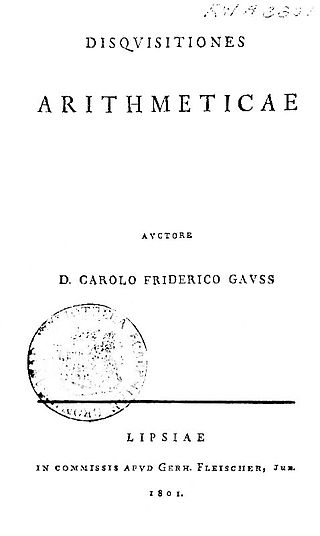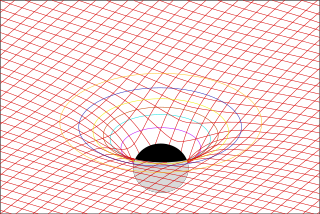In number theory, the Legendre symbol is a multiplicative function with values 1, −1, 0 that is a quadratic character modulo an odd prime number p: its value at a (nonzero) quadratic residue mod p is 1 and at a non-quadratic residue (non-residue) is −1. Its value at zero is 0.

In number theory, the law of quadratic reciprocity is a theorem about modular arithmetic that gives conditions for the solvability of quadratic equations modulo prime numbers. Due to its subtlety, it has many formulations, but the most standard statement is:
The Jacobi symbol is a generalization of the Legendre symbol. Introduced by Jacobi in 1837, it is of theoretical interest in modular arithmetic and other branches of number theory, but its main use is in computational number theory, especially primality testing and integer factorization; these in turn are important in cryptography.

In probability theory and statistics, the beta distribution is a family of continuous probability distributions defined on the interval [0, 1] in terms of two positive parameters, denoted by alpha (α) and beta (β), that appear as exponents of the random variable and control the shape of the distribution.
In mathematics, a reciprocity law is a generalization of the law of quadratic reciprocity to arbitrary monic irreducible polynomials with integer coefficients. Recall that first reciprocity law, quadratic reciprocity, determines when an irreducible polynomial splits into linear terms when reduced mod . That is, it determines for which prime numbers the relation
In number theory, quadratic Gauss sums are certain finite sums of roots of unity. A quadratic Gauss sum can be interpreted as a linear combination of the values of the complex exponential function with coefficients given by a quadratic character; for a general character, one obtains a more general Gauss sum. These objects are named after Carl Friedrich Gauss, who studied them extensively and applied them to quadratic, cubic, and biquadratic reciprocity laws.
In number theory, the Kronecker symbol, written as or , is a generalization of the Jacobi symbol to all integers . It was introduced by Leopold Kronecker.
In mathematics, the Dedekind zeta function of an algebraic number field K, generally denoted ζK(s), is a generalization of the Riemann zeta function. It can be defined as a Dirichlet series, it has an Euler product expansion, it satisfies a functional equation, it has an analytic continuation to a meromorphic function on the complex plane C with only a simple pole at s = 1, and its values encode arithmetic data of K. The extended Riemann hypothesis states that if ζK(s) = 0 and 0 < Re(s) < 1, then Re(s) = 1/2.
In mathematics, Hensel's lemma, also known as Hensel's lifting lemma, named after Kurt Hensel, is a result in modular arithmetic, stating that if a univariate polynomial has a simple root modulo a prime number p, then this root can be lifted to a unique root modulo any higher power of p. More generally, if a polynomial factors modulo p into two coprime polynomials, this factorization can be lifted to a factorization modulo any higher power of p.
Gauss's lemma in number theory gives a condition for an integer to be a quadratic residue. Although it is not useful computationally, it has theoretical significance, being involved in some proofs of quadratic reciprocity.
The Artin reciprocity law, which was established by Emil Artin in a series of papers, is a general theorem in number theory that forms a central part of global class field theory. The term "reciprocity law" refers to a long line of more concrete number theoretic statements which it generalized, from the quadratic reciprocity law and the reciprocity laws of Eisenstein and Kummer to Hilbert's product formula for the norm symbol. Artin's result provided a partial solution to Hilbert's ninth problem.
In mathematics, a Kloosterman sum is a particular kind of exponential sum. They are named for the Dutch mathematician Hendrik Kloosterman, who introduced them in 1926 when he adapted the Hardy–Littlewood circle method to tackle a problem involving positive definite diagonal quadratic forms in four as opposed to five or more variables, which he had dealt with in his dissertation in 1924.
In number theory, the law of quadratic reciprocity, like the Pythagorean theorem, has lent itself to an unusually large number of proofs. Several hundred proofs of the law of quadratic reciprocity have been published.

In physics, Maxwell's equations in curved spacetime govern the dynamics of the electromagnetic field in curved spacetime or where one uses an arbitrary coordinate system. These equations can be viewed as a generalization of the vacuum Maxwell's equations which are normally formulated in the local coordinates of flat spacetime. But because general relativity dictates that the presence of electromagnetic fields induce curvature in spacetime, Maxwell's equations in flat spacetime should be viewed as a convenient approximation.
Cubic reciprocity is a collection of theorems in elementary and algebraic number theory that state conditions under which the congruence x3 ≡ p (mod q) is solvable; the word "reciprocity" comes from the form of the main theorem, which states that if p and q are primary numbers in the ring of Eisenstein integers, both coprime to 3, the congruence x3 ≡ p is solvable if and only if x3 ≡ q is solvable.
In many-body theory, the term Green's function is sometimes used interchangeably with correlation function, but refers specifically to correlators of field operators or creation and annihilation operators.
Quartic or biquadratic reciprocity is a collection of theorems in elementary and algebraic number theory that state conditions under which the congruence x4 ≡ p is solvable; the word "reciprocity" comes from the form of some of these theorems, in that they relate the solvability of the congruence x4 ≡ p to that of x4 ≡ q.
The table of chords, created by the Greek astronomer, geometer, and geographer Ptolemy in Egypt during the 2nd century AD, is a trigonometric table in Book I, chapter 11 of Ptolemy's Almagest, a treatise on mathematical astronomy. It is essentially equivalent to a table of values of the sine function. It was the earliest trigonometric table extensive enough for many practical purposes, including those of astronomy. Centuries passed before more extensive trigonometric tables were created. One such table is the Canon Sinuum created at the end of the 16th century.
In algebraic number theory Eisenstein's reciprocity law is a reciprocity law that extends the law of quadratic reciprocity and the cubic reciprocity law to residues of higher powers. It is one of the earliest and simplest of the higher reciprocity laws, and is a consequence of several later and stronger reciprocity laws such as the Artin reciprocity law. It was introduced by Eisenstein (1850), though Jacobi had previously announced a similar result for the special cases of 5th, 8th and 12th powers in 1839.
In the mathematical field of algebraic number theory, the concept of principalization refers to a situation when, given an extension of algebraic number fields, some ideal of the ring of integers of the smaller field isn't principal but its extension to the ring of integers of the larger field is. Its study has origins in the work of Ernst Kummer on ideal numbers from the 1840s, who in particular proved that for every algebraic number field there exists an extension number field such that all ideals of the ring of integers of the base field become principal when extended to the larger field. In 1897 David Hilbert conjectured that the maximal abelian unramified extension of the base field, which was later called the Hilbert class field of the given base field, is such an extension. This conjecture, now known as principal ideal theorem, was proved by Philipp Furtwängler in 1930 after it had been translated from number theory to group theory by Emil Artin in 1929, who made use of his general reciprocity law to establish the reformulation. Since this long desired proof was achieved by means of Artin transfers of non-abelian groups with derived length two, several investigators tried to exploit the theory of such groups further to obtain additional information on the principalization in intermediate fields between the base field and its Hilbert class field. The first contributions in this direction are due to Arnold Scholz and Olga Taussky in 1934, who coined the synonym capitulation for principalization. Another independent access to the principalization problem via Galois cohomology of unit groups is also due to Hilbert and goes back to the chapter on cyclic extensions of number fields of prime degree in his number report, which culminates in the famous Theorem 94.













































